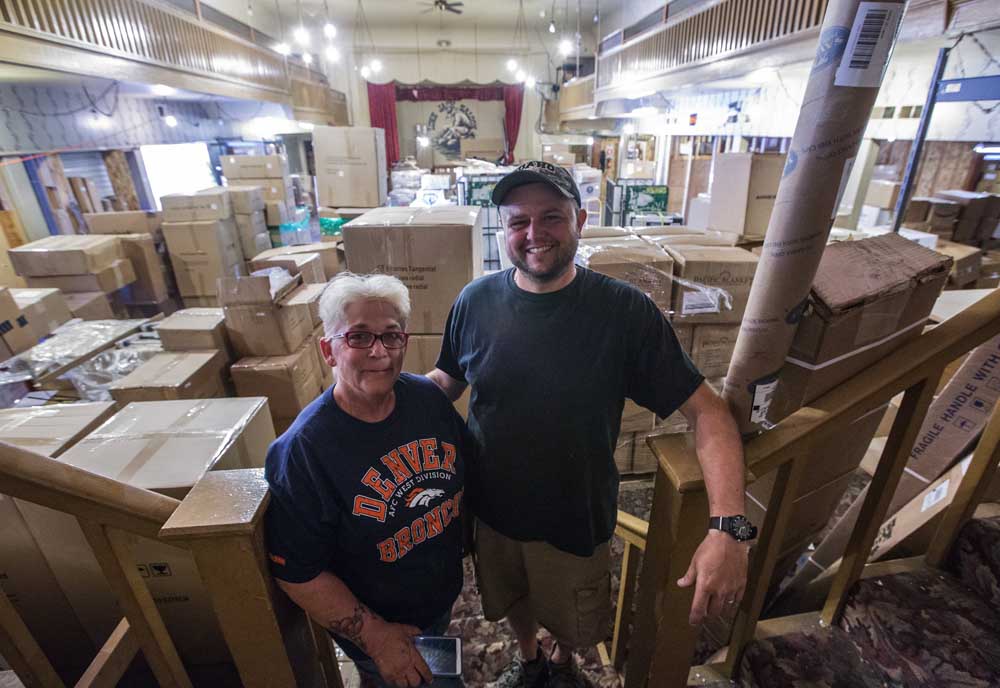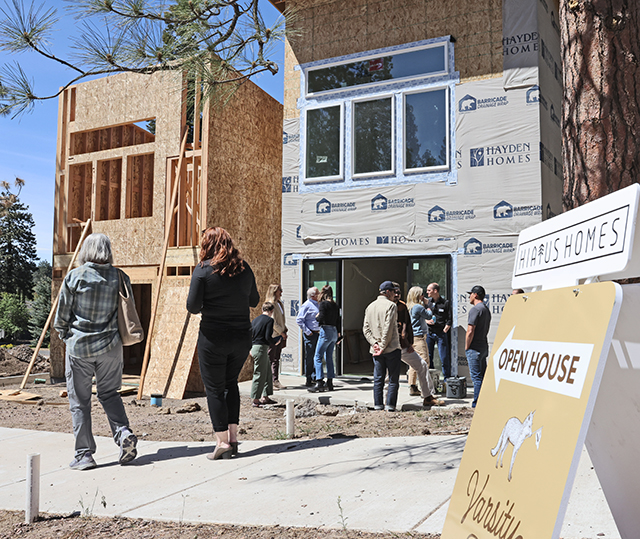Border towns enjoy bonanza of online shopping
Published 12:00 am Sunday, July 12, 2015

- Steve Rignman / The Seattle TimesPackages are stacked up behind O.J. Zeilstra, manager of Ship Happens, and co-owner Lisa Evers in a former opera house and saloon in Sumas, Washington.
SUMAS, Wash. — The Lone Jack Saloon was once among the many taverns in a border town that catered heavily to Canadian carousing.
The stage on which cancan girls used to dance is still there, adorned with a painting of a miner panning for gold. But the floor is now the warehouse for Ship Happens, the largest of eight parcel services that in just a few years have made this farming town of 1,468 a mecca of e-commerce.
“Amazon ships directly to us, a pallet every morning,” said O.J. Zeilstra, the manager.
The cardboard boxes that cram the place are full of stuff that customers from British Columbia buy on U.S. websites, using a Sumas delivery address to avoid lengthy waits at customs and exorbitant international shipping costs.
It’s a few minutes’ drive, or a quick cross-border walk, for the 170,000 residents of the Abbotsford, British Columbia, metro area. Their enthusiasm for Web shopping has made Sumas the state’s top spot for online spending per resident: In 2014 it was $3,013, seven times the figure for Seattle, according to state Department of Revenue data on sales from 20 top online retailers.
Blaine, the last U.S. stop on Interstate 5 en route to Vancouver, also had a disproportionate amount of online shopping: $2,705 per resident.
Most of that e-commerce is by Canadians, not residents — but the jobs and the sales-tax receipts are local just the same.
Even those remarkable numbers sell short the real strength of Internet commerce here. They do not include purchases made at companies such as Nordstrom or Target, which have large online operations but are primarily brick-and-mortar and therefore classified differently by regulators.
A look at U.S. Postal Service figures may help round out the data: A postal spokesman said that last year it handled nearly 400,000 parcels for Sumas, or 272 per resident. That would be 22 times the U.S. average.
The surge of cross-border online shopping is a new twist in the old story of U.S.-Canada trade. Its intensity has meant an unexpected boost for Sumas and other U.S. towns that have long seen their fortunes sway with shifting exchange rates and procedural changes at the border.
“Over the years we’ve seen the economy of Sumas ride the roller coaster of the Canadian dollar,” said Briana Kelley, president of the Sumas Chamber of Commerce.
That ride was often traumatic: In the late 1990s, the town was full of shuttered gas stations, in part victims of a sharp drop in the value of the Canadian dollar. The decline was further compounded by tighter border security after the Sept. 11, 2001, terrorist attacks.
These days, the strengthening U.S. dollar means fewer Canadians are going to big-box stores in U.S. cities like Bellingham, but the growing number of virtual shoppers has buffered the small border communities.
E-commerce “has created a new opportunity for local businesses,” Kelley said.
The Retail Council of Canada estimates that about 30 percent of Canadians’ online transactions are made abroad, mostly in the U.S.
Savings appeal
Because of import tariffs, different pricing and high distribution costs for Canadian retailers, shopping in America can look pretty appealing. Even U.S. retailers operating in Canada suffer: A tire that sells for about $320 at Amazon.ca retails for $227 on the company’s U.S. site.
And there’s much more variety available in the U.S.
“If you’re a Canadian retailer on the border, you’re caught with one hand behind your back,” said Michael LeBlanc, the retail council’s senior vice president for marketing and digital retail.
LeBlanc said Canada’s e-commerce sector is underdeveloped compared with its bigger southern neighbor. For example, Holt Renfrew, a high-end Canadian department store, doesn’t sell products on its website. Neither did Target’s Canada website during that company’s brief foray there.
But the gap won’t last forever, LeBlanc said. More foreign retailers are opening stores north of the border, increasing the assortment of products available to Canadians.
Also, Canadian retailers have embraced U.S. retail holidays like Black Friday and Cyber Monday. A survey by consultancy RetailMeNot.ca showed that 44 percent of shoppers did less holiday shopping in the U.S. because they were able to indulge in those discount extravaganzas at home.
And Canada’s government, under pressure from retailers, has lowered tariffs on products like hockey gear and baby clothes, making those products cheaper than before in Canada.
“The U.S. will always play a role in shopping for Canadians,” LeBlanc said. But “that’s going to get moderated over time.”
Feeling the impact
The U.S. impact of Canadian online shopping can be felt along the entire border. Residents of Ontario pick up their Web purchases in cities such as Buffalo and Detroit.
But it’s perhaps most felt in Washington state, where the border is sparsely populated compared with the highly urban part of British Columbia on the other side.
About 15 percent of British Columbia residents, according to data from a survey by Vancouver consultancy Insights West, have some kind of U.S. mailbox. That’s more people than live in Whatcom County, which borders the most populous part of the Canadian province.
“It means that there is significant impact on e-commerce,” said James McCafferty, assistant director for the Center for Economic and Business Research at Western Washington University in Bellingham.
The impact comes from people like Rhonda Nikkel, an Abbotsford resident who said she often picks up parcels in Sumas twice a week. Generally it’s for books she buys online, but she’s moving more of her shopping to the Web.
“This past Christmas I did all online shopping,” she said. “All from Amazon, shipped to here.”
Pic-It-Up, which bills itself as “100 percent Canadian owned and operated,” was the fourth shipping business in Sumas when it opened four years ago, said owner Richard Simen-Falvy, who lives in Abbotsford. Its opening coincided with a big jump in online commerce.
“The first year was just explosive growth,” he said.
At the Pic-It-Up warehouse on Cherry Street, Sumas’ main thoroughfare, cardboard boxes with customers’ names scrawled on them in black marker, sit until their owners pay a $3 fee and pick them up.
Simen-Falvy said more than 20,000 people have registered with his service as word spread, thanks in part to his YouTube videos.
In these he has impersonated a cowboy holding a banana, a female cheerleader and a suspect under police interrogation. He also explains how to use the service.
“You know your name? You have a computer? You have a Visa that isn’t racked up? Then, if you do, you’re qualified to use Pic-It-Up.”
Other shops include a 24/7 locker service that opened this year.
Even Bob Bromley, the mayor of Sumas, participates in the bonanza: The supermarket he owns holds parcels for a few hundred customers.
The direct tax revenue brought by online sales is estimated at $37,000 by the Department of Revenue for last year, based on the big retailers it tracks. That’s not as much as the taxes collected from the gambling establishments that, according to Bromley, in the early 1990s “financed the whole Police Department.”
But it’s income this town wouldn’t otherwise have, he said. The package places also help other businesses, as visitors fill up on dairy and gas during their parcel runs.
“People come over to pick up their Amazon package and buy an ice-cream cone,” said Rod Fadden, utilities superintendent for the city.






